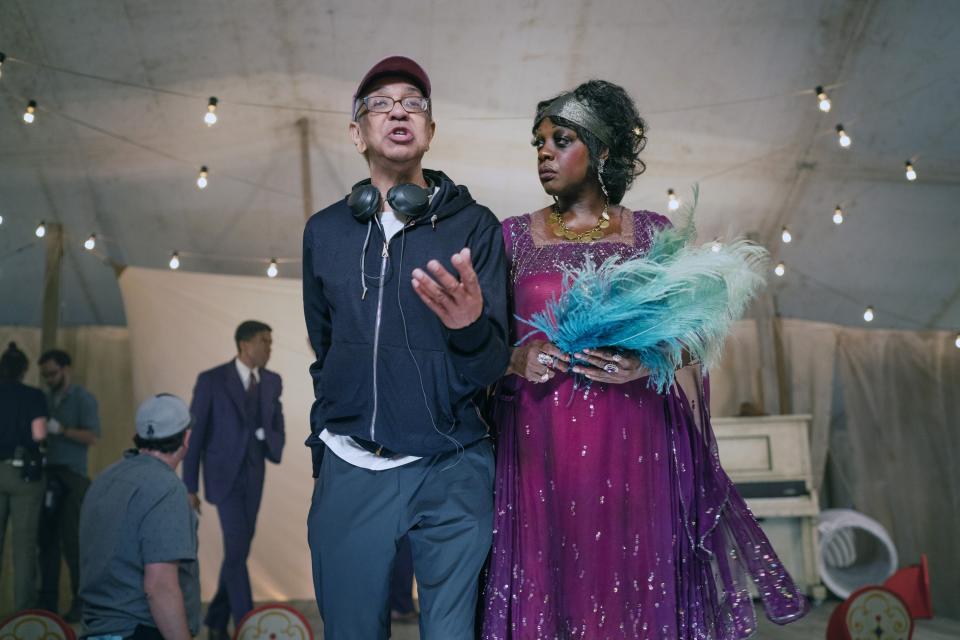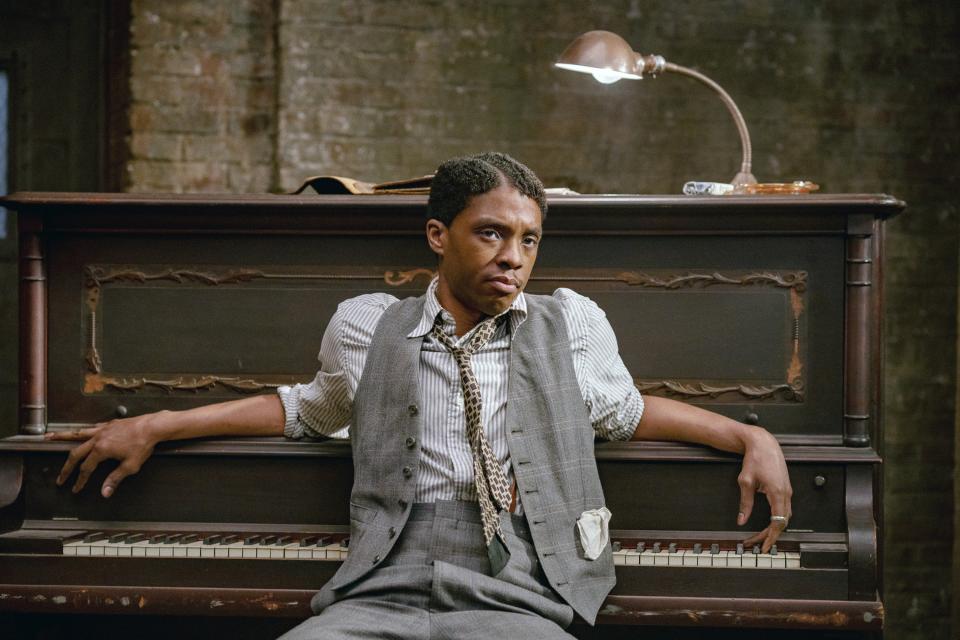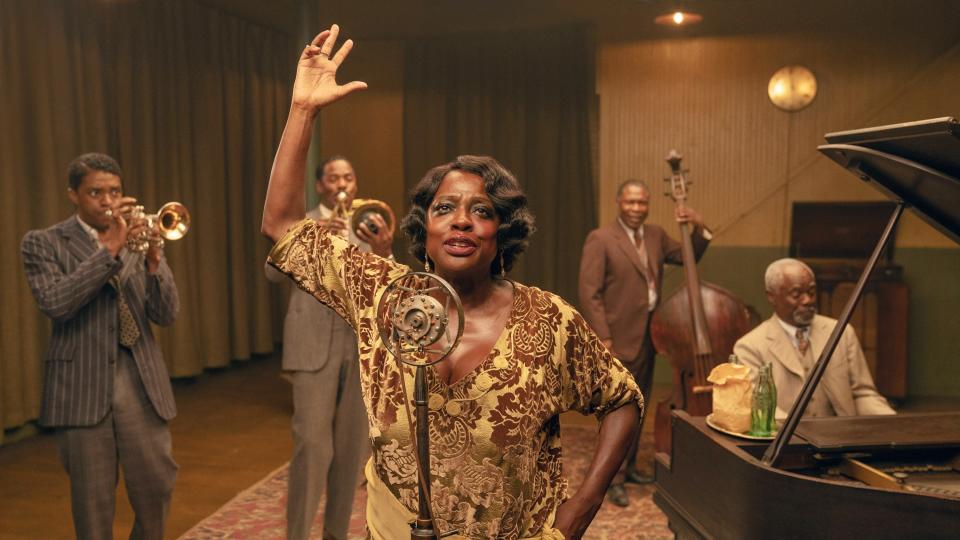George C. Wolfe on Directing Ma Rainey's Black Bottom and Chadwick Boseman
- Oops!Something went wrong.Please try again later.
- Oops!Something went wrong.Please try again later.
- Oops!Something went wrong.Please try again later.
George C. Wolfe is busy, but that’s nothing new. Since emerging as a playwright in the 1980s with works like Paradise and The Colored Museum, the Kentucky-born Wolfe has moved from one high-profile project and position to another. He’s directed landmark theatrical productions like Jelly’s Last Jam, Angels in America, Bring in ‘da Noise, Bring in ‘da Funk and Topdog/Underdog and served a long stint as the artistic director of the Public Theater, achievements that helped earn him a spot in the American Theater Hall of Fame in 2013.
Wolfe’s would be a remarkable career even if he never ventured beyond the stage but, for the past 15 years, theater has only been part of his story. 2005 saw him making his debut as a film director with Lackawanna Blues, an HBO production adapted from a semi-autobiographical script by actor and writer Ruben Santiago-Hudson. Wolfe’s subsequent film work has included Nights in Rodanthe, You’re Not You, and the acclaimed HBO film The Immortal Life of Henrietta Lacks. When asked what he’s working on next, his one-word answer — “stuff” — doesn’t sound curt or coy. It sounds like the response of someone who knows there’s no time to explain it all.
Wolfe’s current project is Ma Rainey’s Black Bottom, a film adaptation of August Wilson’s play about a tense, eventful 1927 recording session presided over by blues giant Ma Rainey. She’s played by Viola Davis as an unbending artist who knows exactly what she wants and a savvy businesswoman who’s learned to navigate an industry filled with people who rarely have her best interests in mind. Davis stars opposite Chadwick Boseman as Levee, a young trumpeter eager to prove himself and strike out on his own with his own band (and maybe steal Rainey’s girlfriend in the process). He’s a man whose easy charm hides a deep, dangerous pain, pain that surfaces over the course of a long, hot Chicago summer day.
Ma Rainey’s Black Bottom would have been an event in any year. It’s filled with remarkable performances — both from its leads and a supporting cast that includes Glynn Turman, Colman Domingo, and Michael Potts — working with Wilson’s rich material as adapted by Santiago-Hudson. (After Fences, it’s the second of Wilson’s ten-play Pittsburgh Cycle to make it to the screen.) Boseman’s death unavoidably casts the film in a different light, giving the already dark material an elegiac quality it might not otherwise have had. It also serves as a final reminder of the actor’s gifts, requiring him to flit between being winning, seductive, and tortured. “It’s a monster role,” as Wolfe puts it. Speaking by phone shortly before the film’s Netflix premiere, Wolfe discussed bringing Wilson to the screen, what Ma Rainey’s Black Bottom says about our relationship to the past, and why it’s pointless to think about theater when you’re making a movie.

MCDMARA ZX028
This is the first time you've worked with August Wilson's material. What was your relationship with his work before making this film?
Well, I was a theatergoer and that was it. I would go see the plays. He and I met once and he talked to me about doing something a long time ago. He was in the process of writing it but I was tied up. I was running The Public Theater at the time. But I [knew his work] primarily as a great admirer.
Did having met him inform your interpretation of the material?
I didn't know him. Ruben, who adapted it, knew him very well. He and I were working in theater circles in New York City, but I didn’t know him. I don’t know Shakespeare. Frequently you don't know the writer. It’s not about the person, it’s about their work and diving into their work and figuring out what you discover.
One striking element of Wilson’s script is his habit of providing detailed descriptions of the characters, their personalities, and their thoughts beyond their dialogue. Did you and the cast find that useful in creating your own interpretation?
It’s valuable. I read them, but no. You’re in a room with smart actors and you've got smart dialogue and you dig in and you try to find the world. Maybe it’s valuable for other people and it's very smart, very revealing, but you’re digging into the material. And also, it’s not in my screenplay. You’re talking about the play, not the film. Those long descriptions don’t exist in the screenplay. So you dive into the material, you dive into the language, you dive into what’s at stake. That’s the focus.
This is the only play in Wilson's Pittsburgh Cycle that’s not set in Pittsburgh, and yet you filmed it in Pittsburgh. Was that inspired in any way by a desire to honor Wilson’s usual setting?
No, it’s poetically ironic, but in Pittsburgh we had a perfect soundstage. And also a lot of the city worked really well for 1927 Chicago. We considered Philadelphia, but the architecture didn't lend itself as much. A lot of people film in Atlanta, but that wasn't an option because that definitely wasn’t going to evoke Chicago. Maybe it was the lure of August’s spirit and personality that drove us there. I was just drawn by the architecture.

MCDMARA ZX027
One decision the adaptation makes is to begin and end with musical performances. Did you feel it important to open with a performance that showed Ma Rainey's effect on an audience?
I think [we wanted] to show her as a woman of accomplishment. That's her tent show that she’s traveling in. She is the boss of that. She has a strong connection with the audience. You see it in the very beginning: people are lined up and it’s Black hands putting coins into other Black hands. That’s, hopefully, what’s being conveyed. I like to call her a showbiz entrepreneur. She toured around and she owned two theaters in Georgia. Yes, I wanted to form a connection between her and the audience. I was very interested in trying to explore that, because at one point she says to her manager, “I don't like it up in the North anyway, so I can take my ass back down South where I belong.” When you think of 1927, of the South, now you think of Jim Crow. But Black people in the South were able to build communities, build businesses, have lives. And she was an incredibly successful entertainer/businesswoman.
It was very important to show that when she showed up in Chicago, she's not coming at the whims of somebody else. She’s coming as a person who was in charge of her career, her life. At one point, [her trombonist] Cutler says, "White people didn’t make Ma a star. Colored people made Ma a star." So I just wanted to do as much as I possibly could to show that she’s not just this sort of aging, would-be desperate person. She’s coming to Chicago with an acute sense of her own power.
Viola Davis has a number of scenes early on as she makes her way from the hotel to the studio where she has no dialogue, but she's completely commanding of the screen and all the other characters. Is there a secret to accomplishing that?
Well, it's having, one, a brilliant actor, and, two, articulating visually what’s at stake. When she's passing through that hotel, she’s walking past people, Black people are saying she doesn't belong, in part because of the way she's dressed, her skin complexion, a series of other things. Also, part of the storytelling is that she is an outsider and she is not of Chicago. She is not of Chicago when she's passing through that hotel, she’s not of Chicago when she gets into that confrontation with the policeman, she is her own island who is navigating her way and navigating her power through the power structures of that existence in Chicago.
The thing that always comes up when you're adapting a play is how do you open it as a film? Was that a concern for you?
No, it's a film. I'm doing a film. I'm not thinking about the play. I’m thinking about the material. I understand the question but it's like you're cooking fish and somebody is saying, "Well, how did you not cook chicken?” I was making fish. So I wasn't thinking about the play. When the play is done it’s a unit set that shows the band room and the recording room. That wasn’t part of my vocabulary. I was dealing with something else. I was dealing with the script and the story. I was dealing with, what did I think visually — working in tandem with the screenwriter — needed to be conveyed to help an audience become consumed with the story that was being told. I'm not thinking about, "Oh, it’s a play now, now it’s a film." That's not a part of my thought process. My thought process is, I’m working on a film and this is a story. And what visual elements do I need to include so that the audience knows every single thing they need to know so they feel comfortable and in command as they're following the story along?

MCDMARA ZX003
After a lot of heroic parts, this is Chadwick Boseman's most morally thorny role since playing James Brown in Get On Up. Do you feel like that was part of the attraction of the material?
Anybody in any occupation loves challenges and loves hard work. If it's somebody that's in command of their craft, I don't care if it's acting or a chef or a basketball player or a schoolteacher, everybody loves the challenge. And everybody loves the opportunity to dive into a landscape where they will be challenged and can explore new muscles and all the muscles that they possibly have. I did Ma Rainey and the next thing I want to do [will be] something completely different. I’m going to grow and it's going to be more fun to use completely different muscles. I think that was, without question, what excited Chadwick about the role. And it’s a monster role and it’s a thrilling role, it’s a difficult role. All of those things are exhilarating for an actor. And he rose to the occasion and more than delivered. He's a brilliant actor.
This is a story set in 1927. It was first staged in 1982. What makes it resonate in 2020?
I think that's a question for audiences more than it is for me. One of the things that is very interesting and exciting about it is that it’s about America and America is kind of stuck wrestling with the issue of its future versus its past. Arrogant people foolishly believe that the way to go charging into the future is by pretending that the past isn't there. Levee tries to do that in many respects. And we find out about what a complicated and painful past he has, and about those unresolved emotional feelings — and they’re unresolved understandably, because he witnessed something so violent when he was at a very young age that the consequences of that are still with him and still haunting him.
I think America is still haunted by its past and healing comes, not from pretending the past wasn’t there, but from going inside of the past and exploring it and coming out on the other side with strength and power and knowledge and, hopefully, grace. That’s one of the things that’s fascinating to me about the piece. And I think it’s [true of] a lot of material. Death of a Salesman is about a changing world and Willy Loman feels as though he doesn't know how to compete in that world. Ma, I think, is dealing with some of that as well, because Bessie Smith starts to usurp her in ticket sales. There are these themes that exist inside of a lot of American novels, plays, and films, because there are still certain questions that are intrinsic and unresolved within the culture at large.
Originally Appeared on GQ

